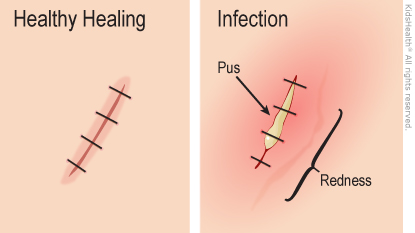When a child gets a laceration (cut) on the chin, a health care provider will carefully check it and examine the jaw to see if the bone was injured. Often, a cut needs stitches to bring the two sides of skin closer together. Most cuts will leave a small scar. A healing cut can get infected, so the health care provider cleaned it carefully. You can help to prevent infection by taking good care of the cut as it heals.




The wound:

Can a chin injury hurt the jaw or teeth? A bump or blow to the chin can sometimes injure the jawbone or teeth. Health care providers examine the jaw and teeth carefully before fixing the chin cut. Sometimes an X-ray is needed. Kids might notice soreness when they chew or open their mouth for a few days even if there is no jaw fracture.
What will happen to the stitches? Some stitches need to be removed by a health care provider. Others, called absorbable, dissolve on their own. How long stitches stay in the skin will depend on the kind of cut and where it is. Sometimes, small white sticky tapes called butterfly bandages are put over the stitches to give them extra strength. These tapes loosen in a few days and fall off on their own.
Why does a cut get a scar? When the deeper layer of the skin is injured, the body uses a protein (collagen) to help fill in the cut area. The filled-in area becomes a scar. A scar can form even if a cut is fixed with stitches. Over time, some scars fade or get smaller.